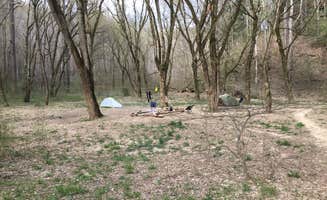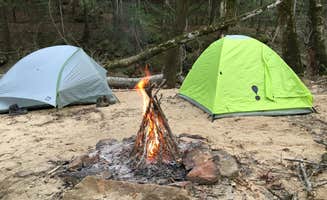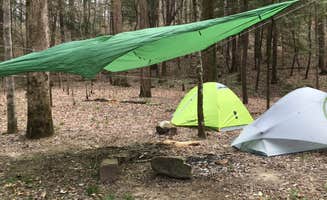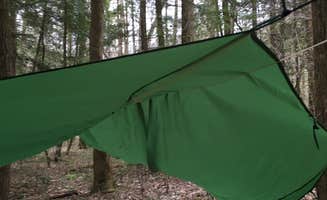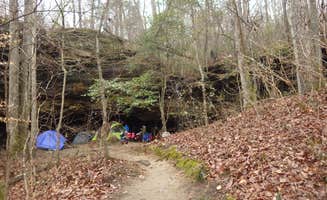Sipsey Wilderness in Bankhead National Forest spans over 25,000 acres in Northwest Alabama near Double Springs. The forest features a diverse topography of deep ravines, sandstone cliffs, and upland ridges with elevation changes up to 400 feet in some sections. Hiking and tent camping Double Springs, Alabama experiences vary dramatically by season, with water levels in multiple streams fluctuating between near-dry conditions during summer droughts and flowing waterfalls after significant rainfall periods.
What to do
Waterfall hiking: 1-3 mile trails lead to several notable cascades within the wilderness area. "The entire Sipsey Wilderness is gorgeous, but if you want a trail with lots of great spots to camp, this trail is fantastic... Most of the time, except during dry spells, there are LOTS of waterfalls," notes a visitor at Thompson Creek Trail Campsites. These falls are most impressive during winter months or after heavy rain.
Water access recreation: Multiple stream crossing points along trails provide opportunities for wading and cooling off. A camper at Sipsey Wilderness - Trail 200 Campsites noted, "It is a wonderful site and well worth claiming early since it is close to the parking area, has easy access to the river where you can pump water and swim."
Nature photography: Early morning light on sandstone bluffs creates optimal conditions for capturing landscape photographs. "The water is a beautiful turquoise. Most of the campsites have giant moss covered boulders all around, and cliffs in the background opposite the river," reported one visitor describing the photographic opportunities at Thompson Creek.
What campers like
Elevated camping spots: Many tent campers prefer sites positioned on higher banks. "This site is situated nice and high up on the bank so you should be well protected from flooding," explains a camper at Sipsey Wilderness Backcountry Site (Trail 200 Site I).
Sandy tent pads: Natural sand tent platforms at numerous sites provide comfort without tent footprints. At Sipsey Wilderness Backcountry Site (Trail 207 Site B), a camper reported, "the flat tent areas at this site are mostly covered in sand which means you will have a very comfortable surface to sleep on."
Rock features for sitting and dining: Unique natural formations serve practical purposes at campsites. "Theres a beautiful large boulder rock that overlooks Thompson Creek you can relax on or have meals on," wrote one camper about their site.
What you should know
Water filtration necessities: All drinking water requires treatment before consumption. "You won't find bathrooms or drinking water nearby, but if you're looking to really get away from it all and do some primitive camping, this is a great place to go," advises a Thompson Creek visitor.
Variable site privacy: Proximity to trails affects seclusion levels at different sites. A camper at Sipsey Wilderness Backcountry Site (Trail 200 Site H) mentioned, "This site, in particular, is one of my favorites to stay at... and is secluded from many other sites. It shows up in a bend in the trail after you cross over one of the small creeks."
Creek crossing challenges: Water levels determine ease of traversing waterways. "You do have to cross a stream, which was not as difficult for my 6'2 husband as it was for me at 5'2. The water was clear," reported one Thompson Creek hiker, highlighting how height can affect crossing difficulty.
Tips for camping with families
Shallow water play areas: Specific creek sections provide safer wading for children. "Also lots of shallow places for the kids to play in the water. Watch for snakes and bring bug spray," advises a camper who visited Thompson Creek with family.
Short hiking options: For families with young children, consider the closest access points. "Me and my 6 year old daughter hiked the trail this past Saturday... Had a great time," shared a parent about their Thompson Creek experience.
Multiple tent group sites: Some locations specifically accommodate family-sized groups. At Sipsey Wilderness Backcountry Site (Trail 200 Site G), a reviewer noted it "is by far the best site if you have a group of 3 or more tents. It has several firepits and is spread out over a large area. Each individual site has enough privacy while still providing group areas to congregate."
Tips from RVers
Road condition awareness: Access roads to trailheads vary in maintenance quality. "The roads aren't the best but my van made it despite the muddy potholes," reported one visitor at Thompson Creek, providing context for drivers of larger vehicles.
Primitive roadside camping options: Some areas permit vehicle camping near forest roads. "Stayed just off the main road about a mile at a previously made campsite... No cellular but ok enough data," noted a camper who chose not to hike into the backcountry with their van.
Trailhead parking limitations: Vehicle size constraints affect access to hiking entry points. Some parking areas accommodate standard vehicles but present challenges for larger rigs, requiring advance planning for RV travelers interested in accessing tent camping areas.


